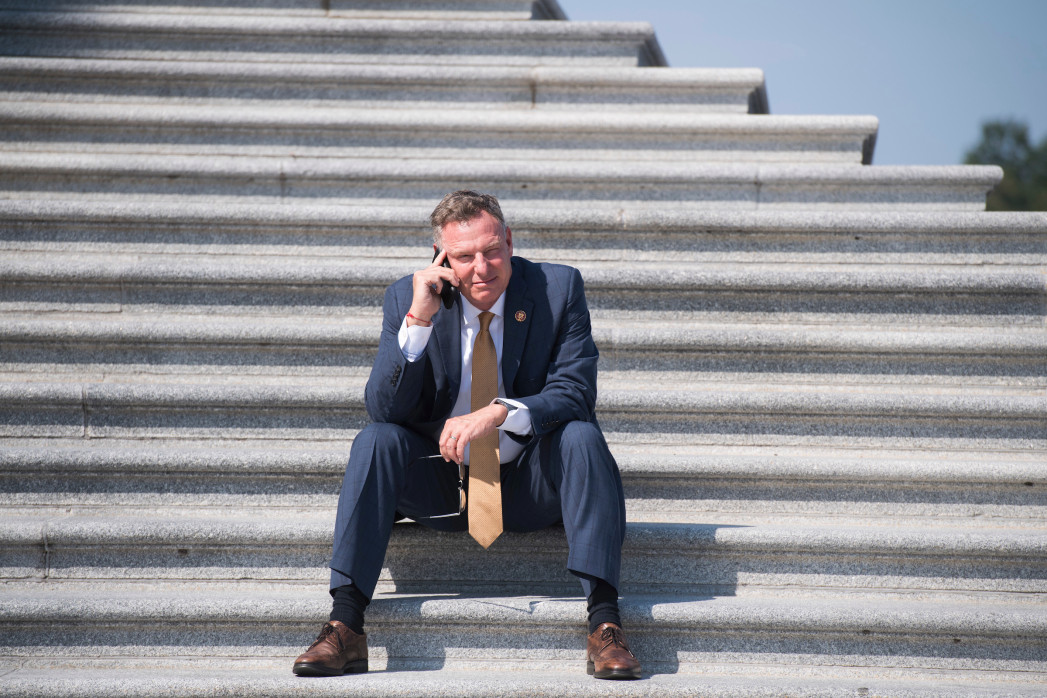Roll Call: These Democrats want automatic triggers to keep coronavirus relief flowing
New Democrat Coalition leads the push for using automatic stabilizers to provide businesses, families certainty that aid will come as needed
A growing number of House Democrats are pushing an idea to provide more certainty to American families and businesses that need help from the federal government to financially weather the coronavirus pandemic.
For nearly a month, the New Democrat Coalition has called for automatic stabilizers — a mechanism for keeping government assistance flowing by tying relief programs to economic or timing triggers — to be added to coronavirus relief legislation.
“As appropriate, build automatic stabilizers into direct assistance programs to provide certainty and trigger additional assistance and stimulus without the need for additional congressional action if economic conditions continue or worsen,” the coalition wrote March 19 in a list of principles and priorities for responding to the economic challenges associated with the pandemic.
Rep. Derek Kilmer of Washington, chairman of the New Democrat Coalition, will soon release legislation proposing an automatic stabilizer for the popular Paycheck Protection Program, which provides loans to small businesses that will be fully forgiven if the companies keep a majority of their employees on the payroll. PPP is expected to run out of money by the end of the week and negotiations over a bill to add funds are at a standstill.
The coalition is also looking at other relief measures that could benefit from automatic stabilizers, like direct payments to low- and middle-income Americans, expanded unemployment benefits and funding for states and hospitals.
“Rather than having Congress play whack-a-mole and stick their fingers in the dike, there is strategic value in building triggers in the system,” Kilmer told CQ Roll Call. “To me, the problem we’re trying to solve for is how do you create some certainty for people in really uncertain times.”
California Rep. Scott Peters, one of the New Democrat Coalition vice chairmen, said the group had raised automatic stabilizers for consideration in the $2.3 trillion economic relief package, but none were included.
They’re hoping that House leadership, which is taking a larger role in drafting the next big package, will consider including stabilizers. New Democrats have raised the idea on various Democratic Caucus conference calls and more formally in an April 2 letter to leadership.
“Leadership has never argued with it,” Peters said. “I think they’re taking a lot of inputs.”

California Rep. Scott Peters is among the members of the New Democrat Coalition seeking to include
automatic stabilizers in coronavirus relief packages. (Tom Williams/CQ Roll Call file photo)
‘Reasonable, rationale proposal’
House Majority Leader Steny H. Hoyer said in an interview April 7 that the New Democrats’ idea to use automatic stabilizers to keep relief flowing “makes sense given the problems that we have.”
“I’m not saying that that’s going to be in the CARES 2,” the Maryland Democrat said, using a shorthand name for the next big economic response package. “But I am saying that that is a very reasonable, rationale proposal in response to both the need to get resources to meet a problem as quickly as possible and also to provide … these means without having to vote again, because we will have provided by law that this will automatically occur. So I think it’s going to get consideration.”
The Ways and Means Committee, which has jurisdiction over the direct payments and unemployment benefits, is consulting with leadership and the entire Democratic Caucus as it considers “a variety of strategies to ensure Americans receive the support they need throughout this crisis,” spokeswoman Erin Hatch said.
But some committees working on the next package are not currently considering automatic stabilizers.
The House Appropriations Committee, which has jurisdiction over providing funding for states and hospitals, believes the best way to ensure the aid continues flowing during the pandemic “is through continued legislation that allows Congress to keep a watchful eye on what’s working and what isn’t,” according to a Democratic aide who requested anonymity to describe the panel’s thinking.
“We don’t support putting programs on autopilot, especially when it is obvious that the Trump administration requires constant, diligent oversight,” the aide said.
Leaders may also be concerned about giving up negotiating leverage since bipartisan will to provide critical relief usually opens the door to compromise in other areas where parties normally wouldn’t budge.
Despite such concerns, interest in automatic stabilizers is growing beyond the New Democrat Coalition. The Congressional Progressive Caucus, the second-largest Democratic ideological caucus next to the New Democrats, sent a letter to leadership April 9 identifying “automatic triggers that tie assistance to economic conditions” among three principles they believe Democrats should follow in the next relief bill.
The subject had come up a day earlier during a Democratic Caucus call with Vice President Mike Pence and the administration’s coronavirus task force through a question New Democrats had submitted. Pence said he’d raise the idea with Treasury Secretary Steven Mnuchin, the administration’s lead negotiator for relief legislation, who had been on the call but had dropped off by the time the question was asked.
“The New Dems, that’s always the first question we’re asking,” Peters said.
‘This is the problem’
The coalition members pointed to the current impasse over an interim bill to add more funding to the Paycheck Protection Program as a prime example of why automatic stabilizers are needed. Both parties agree that the program needs more money, but Democrats are also pushing for additional funds for states, hospitals and coronavirus testing, while Republicans don’t want to negotiate.
“This is the problem with not doing direct triggers. We could see this kind of herky-jerky, ad hoc response every week,” Peters said.
Kilmer’s bill to keep the PPP afloat would use a timing stabilizer to tie the program to the duration of the national emergency for the coronavirus pandemic, sunsetting the program 30 days after the emergency declaration ends and allowing borrowers to request extensions of the eight-week loans as needed. Kilmer said his bill would also provide $900 billion for the program, with a provision mandating that any unobligated funds be returned to the Treasury when it sunsets.
Fellow Washington Democratic Rep. Suzan DelBene, a coalition vice chairwoman, said having seen the first U.S. coronavirus cases appear in her district, she knows firsthand “how important it is that people have some certainty about what resources are going to be available to help them out.”
She said New Democrats are open to discussing how best to structure automatic stabilizers, saying some could be based on the duration of the pandemic while others may be better tied to economic indicators.
“We could set milestones where that triggered either additional response or a longer period of time where something would be available so, again, it’s not subject to another piece of legislation,” DelBene said.
The coalition has floated a few ideas for how stabilizers could be used. One option would use the unemployment rate to trigger an extension of the additional $600-per-week unemployment insurance benefit, which the previous package authorized through July, if conditions continue or worsen. The trigger could also be designed to phase out the benefit as the pandemic drags on or conditions improve.
The coalition has also suggested using state unemployment rates as automatic stabilizers for determining federal Medicaid reimbursement rates, known as Federal Medical Assistance Percentages (FMAP). Under one scenario being discussed, if a certain state unemployment rate threshold is met, it could trigger an increase in the FMAP for that state, linking the percentage increase in the benefit to the percentage increase in the unemployment rate.
Beyond the pandemic?
In May 2019, long before the novel coronavirus emerged, The Hamilton Project at the Brookings Institution put out a book proposing a range of automatic stabilizers that could be built into the economy to protect against recessions. The New Democrat Coalition has used the project and its director, Jay Shambaugh, as a resource in developing its ideas.
“I think there’s some recognition that they can’t be in massive response mode writing a new bill every week,” Shambaugh told CQ Roll Call. He said he hopes that if Congress adopts automatic stabilizers for its coronavirus response, it would “leave them there for the next recession.”
The unemployment rate is a good way to judge the onset of a recession, and thus one of the best triggers that can be used to determine when relief needs to be turned on — but also when it needs to be turned off, Shambaugh said. He envisions it being used for expanded unemployment and food assistance benefits, as well as aid to states that are already making difficult decisions in laying off or furloughing workers in preparation for budget shortfalls.
For programs like PPP that are specific to the coronavirus pandemic and businesses being shut down due to stay-at-home orders, Shambaugh said other triggers like ones tied to the duration of the shutdowns would likely make more sense.
In the Senate, Colorado Democrat Michael Bennet has championed the need for automatic stabilizers to expand fiscal programs whenever the economy deteriorates. He has proposed sweeping changes to unemployment insurance that would use three triggers related to the unemployment rate to turn expanded benefits on and off as needed. The proposal is part of a broader series of economic legislation he plans to introduce that use automatic stabilizers.
Bennet also has a coronavirus-specific proposal with Sens. Sherrod Brown, D-Ohio, and Cory Booker, D-N.J., that uses automatic stabilizers to determine how long the government should dole out direct payments to families.
Kilmer and DelBene said the New Democrat Coalition’s discussions of automatic stabilizers has been focused on the pandemic, but Peters said he hopes any adopted for that purpose could serve as “baby steps” toward using stabilizers to prepare for future recessions.
“To me, I think the concept is something worthy of broader adoption,” Peters said.
So far it’s mostly Democrats pushing for automatic stabilizers. The top House Republican shut down the idea when CQ Roll Call asked about it during a press call Thursday.
“I don’t believe we need that,” House Minority Leader Kevin McCarthy, R-Calif., said. “I believe Congress has its role, and Congress can act.”
But one ancillary benefit that could get both parties on board is that adopting triggers for the most crucial bipartisan relief programs would prevent members having to rush back to Washington in the middle of the pandemic to pass new legislation every few weeks.
Peters said that’s part of New Democrats’ argument: “We’re telling people to work from home, so it looks a little bit out of touch, if not hypocritical, if we’re getting on a plane every two weeks.”
By: Lindsey McPherson
Source: Roll Call
Next Article Previous Article
